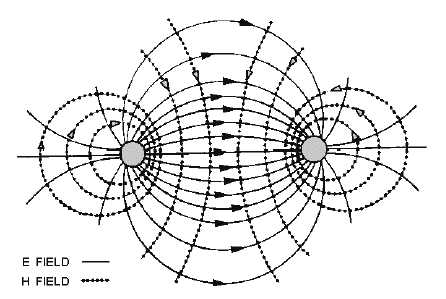3-13
Conductance in transmission lines is expressed as the reciprocal of resistance and is usually given in
micromhos per unit length.
Figure 3-13.—Leakage in a transmission line.
ELECTROMAGNETIC FIELDS ABOUT A TRANSMISSION LINE
The distributed constants of resistance, inductance, and capacitance are basic properties common to
all transmission lines and exist whether or not any current flow exists. As soon as current flow and
voltage exist in a transmission line, another property becomes quite evident. This is the presence of an
electromagnetic field, or lines of force, about the wires of the transmission line. The lines of force
themselves are not visible; however, understanding the force that an electron experiences while in the
field of these lines is very important to your understanding of energy transmission.
There are two kinds of fields; one is associated with voltage and the other with current. The field
associated with voltage is called the ELECTRIC (E) FIELD. It exerts a force on any electric charge
placed in it. The field associated with current is called a MAGNETIC (H) FIELD, because it tends to
exert a force on any magnetic pole placed in it. Figure 3-14 illustrates the way in which the E fields and H
fields tend to orient themselves between conductors of a typical two-wire transmission line. The
illustration shows a cross section of the transmission lines. The E field is represented by solid lines and
the H field by dotted lines. The arrows indicate the direction of the lines of force. Both fields normally
exist together and are spoken of collectively as the electromagnetic field.
Figure 3-14.—Fields between conductors.



